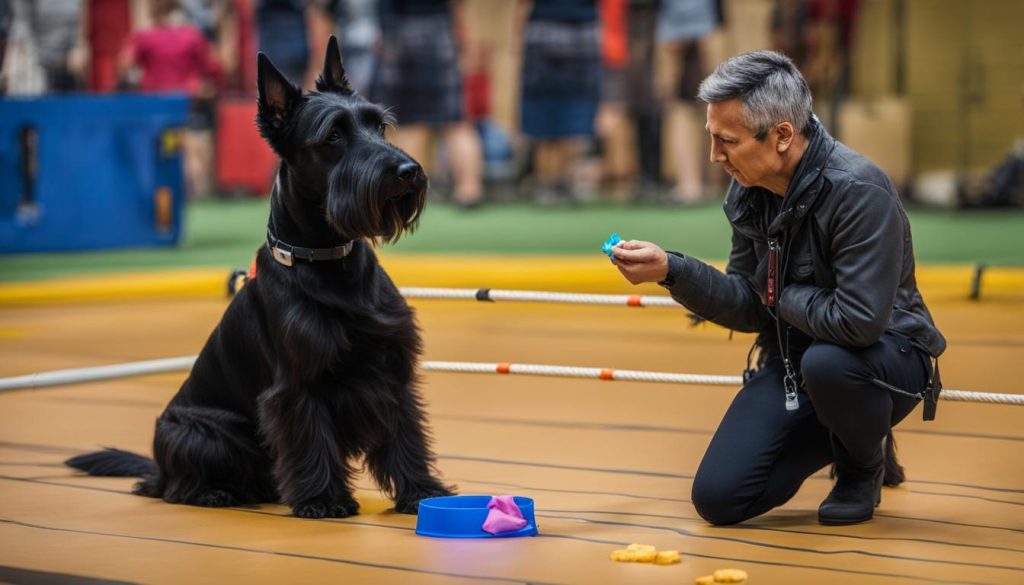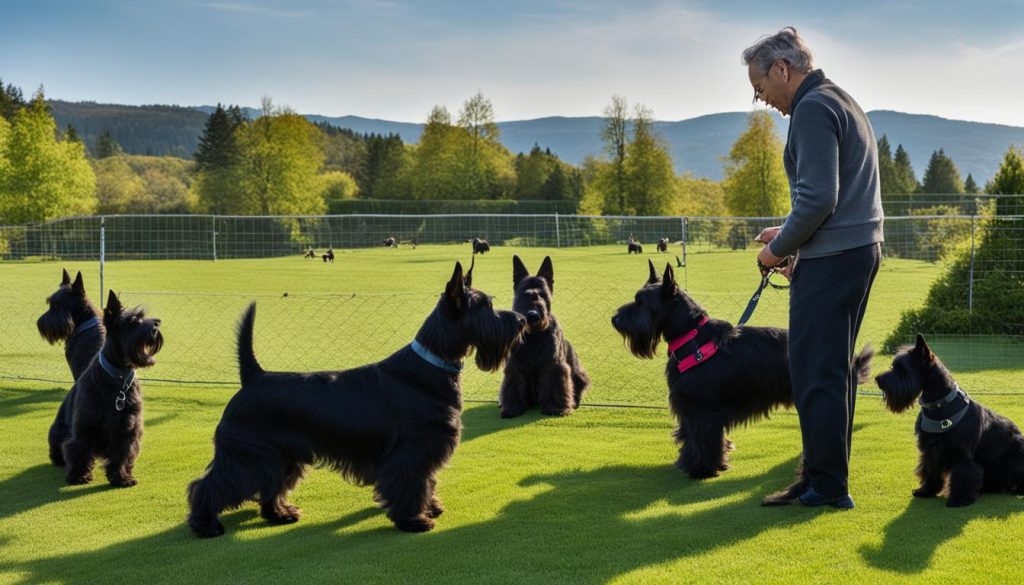Training a Scottish Terrier can be a rewarding experience, but it requires patience and a positive attitude. As an experienced dog trainer, I’ve gathered valuable insights on how to train Scottish Terriers effectively. In this article, I will share essential tips and techniques that will help you train your Scottie to be a well-behaved and joyful companion. Let’s dive in!
How to Do Scottish Terrier Training Easily
- Set realistic expectations and create a positive training environment.
- Use positive reinforcement techniques, such as rewards, for effective training.
- Short, regular training sessions are more effective than long, infrequent ones.
- Teach essential commands like sit, stay, come, and down for obedience training.
- Establish a consistent feeding routine and healthy diet for house training.
The Importance of a Positive Attitude in Scottish Terrier Training
Approaching Scottish Terrier training with a positive attitude is crucial for success. Training can sometimes be challenging, but maintaining a positive mindset can make the process more enjoyable for both you and your furry companion. Patience is key when training a Scottish Terrier, as they have an independent and stubborn nature. By remaining positive and patient, you can effectively teach your Scottie the desired behaviors and commands.
During the training sessions, it is essential to create a nurturing and encouraging atmosphere. When your Scottish Terrier displays even small improvements, be sure to praise and reward them. Positive reinforcement, such as treats, verbal praise, or their favorite toy, can motivate and strengthen their learning process.
It’s important to remember that Scottish Terriers thrive in an environment free from fear, punishment, or negative reinforcement. Using force or intimidation can create anxiety and hinder their training progress. Instead, focus on building a strong bond with your Scottie through trust, respect, and positive interactions.
Another aspect of maintaining a positive attitude is embracing the individuality of your Scottish Terrier. Each dog has a unique personality and may respond differently to training methods. By adapting your approach and being flexible, you can tailor the training to suit your Scottie’s specific needs and learning style.
Lastly, don’t forget to celebrate the small victories along the way. Training a Scottish Terrier requires time, consistency, and patience. Recognize and appreciate their progress, no matter how small it may seem. Having a positive attitude throughout the training journey will not only benefit your Scottie but also deepen the bond between you.
Essential Commands and Obedience Training for Scottish Terriers
When it comes to Scottish Terrier training, teaching essential commands and obedience is crucial. By instilling these commands in your Scottie, you can ensure a well-behaved and obedient companion. Training your Scottish Terrier should focus on positive reinforcement techniques to foster a strong bond between you and your furry friend.
Consistency is key when giving commands to your Scottish Terrier. By using the same verbal cues and hand signals, you can help them understand and respond correctly. Start with basic commands such as sit, stay, come, and down. These essential commands form the foundation of obedience training and can be taught through repetition and reward-based training.
Short, regular training sessions are more effective than longer, infrequent ones. The attention span of a Scottish Terrier is relatively short, so it’s important to keep training sessions engaging and enjoyable. Break down each command into simple steps and gradually increase the difficulty as your Scottie progresses.
- Practice the sit command by gently pushing their hindquarters down as you say “sit”. Reward them with verbal praise and a treat when they comply.
- For the stay command, reinforce the behavior by gradually increasing the duration of the stay and rewarding them for staying put.
- Teaching the come command involves calling your Scottie towards you and rewarding them when they reach you. This command is essential for their safety and helps prevent them from running off.
- The down command is best taught by luring your Scottish Terrier into a lying position using a treat. Gradually reduce the luring gesture and reward them for lying down on command.
During obedience training, it’s important to use rewards such as treats and verbal praise to reinforce the desired behaviors. This positive reinforcement approach creates a positive association with the commands and helps motivate your Scottish Terrier to follow them.
It’s crucial to avoid scolding or punishing your Scottie if they don’t immediately respond to a command. Negative reinforcement can create a negative association, making it harder for them to learn and hindering trust in the training process.

House Training for Scottish Terriers
House training is a crucial part of Scottish Terrier training. Establishing a consistent routine for feeding and potty times is essential to teach your Scottie where they should eliminate. Scottish Terrier puppies should be taken outside frequently, particularly after meals, to prevent accidents indoors. As they grow older, gradually increase the interval between potty breaks.
To make the process more effective, choose a specific area outside for your Scottie to use as their bathroom. Using cue phrases like “go potty” can help them associate the command with the action. Remember to reward your dog with praise and treats when they successfully go to the bathroom outside, reinforcing the behavior.
If accidents occur indoors, it’s important to clean them thoroughly to remove any scent that may attract your Scottie to the same spot. Additionally, redirect your dog to the correct spot outside to reinforce the desired behavior.
House training your Scottish Terrier requires consistency and patience, but with time and effort, your Scottie will learn where and when to eliminate, making life easier for both of you.
Socialization Training for Scottish Terriers
Socialization training plays a crucial role in the development of Scottish Terriers, enabling them to interact confidently with other dogs, people, and various environments. The ideal time to start socialization is when your Scottie is a young puppy, ideally between 3 and 12 weeks of age. During this critical period, exposing them to different situations, individuals, and pets in a positive and safe manner lays the foundation for their adaptability and confidence.
One effective way to socialize Scottish Terriers is through puppy classes. These classes not only provide opportunities for socialization with other dogs but also create a structured setting for learning basic commands and behaviors. It is important to choose reputable classes conducted by experienced trainers who emphasize positive reinforcement techniques.
- Introduce your Scottish Terrier to a variety of people, including children, adults, and individuals wearing hats or uniforms. This exposure helps the dog become comfortable with different appearances and behaviors.
- Gradually expose your Scottie to a range of environments, such as parks, beaches, busy streets, and shopping centers. This exposure helps them become familiar with different sights, sounds, and smells, reducing the likelihood of fear or anxiety in new situations.
- Arrange playdates with friendly and well-socialized dogs, ensuring that each interaction is supervised and positive. This allows your Scottie to learn appropriate social skills and develop good behavior around other dogs.
Remember that socialization is an ongoing process, requiring regular and repeated exposure to new experiences. Reinforce positive behaviors during socialization training with treats, praise, and gentle petting. Above all, ensure that each interaction remains positive and stress-free, as negative experiences can hinder the socialization progress.
By providing your Scottish Terrier with ample socialization training and exposure to diverse experiences, you can help them grow into confident and well-adjusted companions.

Getting Your Scottie Used to Grooming
Grooming is an important aspect of Scottish Terrier training. Regular brushing is necessary to prevent tangles and matting. To effectively groom your Scottie, I recommend using a high-quality slicker brush or pin brush and brushing their fur in the direction of hair growth. This gentle brushing action helps to remove loose fur and keep their coat looking its best.
Another essential grooming task is bathing, which should be done every 4 to 6 weeks using dog-friendly shampoo and conditioner. It is important to choose products specifically formulated for dogs to avoid any skin irritations. When bathing your Scottie, ensure that you thoroughly rinse out all the shampoo and conditioner to prevent any residue from causing discomfort.
- Regular brushing helps prevent tangles and matting
- Use a high-quality slicker brush or pin brush
- Brush in the direction of hair growth
- Bathe your Scottie every 4 to 6 weeks
- Use dog-friendly shampoo and conditioner
- Rinse out all shampoo and conditioner thoroughly
In addition to brushing and bathing, regular grooming sessions provide an opportunity to check your Scottie’s skin for any issues, such as fleas or ticks. By carefully inspecting their skin during grooming, you can catch any potential problems early and seek appropriate treatment if necessary. Remember to handle your Scottie with care and provide positive reinforcement throughout the grooming process.
Gradually introducing your Scottie to grooming from an early age is crucial. Start by gently brushing them for short periods and offering treats and praise to associate grooming with positive experiences. By creating a calm and positive grooming environment, your Scottie will become more comfortable with the process over time.
Conclusion
Training a Scottish Terrier requires patience, a positive attitude, and consistency. By following the tips and techniques mentioned in this article, you can successfully train your Scottie to be an obedient and joyful companion. Remember, each dog is unique, so training methods may need to be adjusted based on your individual dog’s needs.
With time and effort, Scottish Terriers can become well-trained and well-behaved members of your family. Positive reinforcement techniques, such as using rewards and praise, are effective for teaching your Scottie essential commands and obedience. Establishing a consistent routine for house training and grooming is crucial for their overall well-being.
By socializing your Scottish Terrier from a young age, you can help them become confident and comfortable in various situations. Puppy classes and regular exposure to new experiences can greatly contribute to their socialization skills. Remember, training a Scottish Terrier is a journey that requires dedication and a loving approach.
FAQ
What are some tips for successful Scottish Terrier training?
Some tips for successful Scottish Terrier training include approaching training with a positive attitude, using positive reinforcement techniques, and having patience. Consistency and short, regular training sessions are also key.
What are some essential commands for Scottish Terrier training?
Some essential commands for Scottish Terrier training include sit, stay, come, and down. These commands should be taught using positive reinforcement techniques and consistency.
How do I house train my Scottish Terrier?
House training a Scottish Terrier involves establishing a consistent routine for feeding and potty times. Taking the puppy outside frequently and using cues and rewards for successfully going to the bathroom outside are important components of house training.
Why is socialization training important for Scottish Terriers?
Socialization training is important for Scottish Terriers to learn how to interact with other dogs, people, and different environments. Starting socialization when the dog is a puppy and exposing them to various situations in a positive and safe manner helps them become confident.
How do I get my Scottie used to grooming?
Getting your Scottish Terrier used to grooming involves starting early, using positive reinforcement, and gradually introducing them to grooming tasks such as brushing and bathing. Regular grooming sessions and a positive approach can help them become comfortable with the process.






